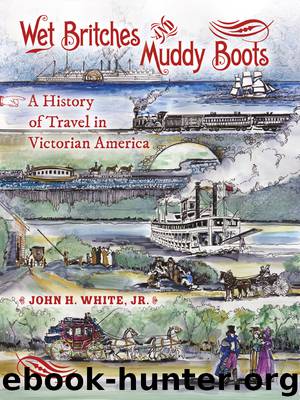Wet Britches and Muddy Boots by John H. White

Author:John H. White
Language: eng
Format: epub
Publisher: Indiana University Press
9.3a & 9.3b. The Old Colony dating from 1865 experienced an unfortunate engine failure in 1878 when one end of the walking beam fractured and crashed through the vessel's cabin. There were no injuries to crew or passengers.
(Scientific American, May 25, 1878)
The Empire State was somewhat newer than the Bay State and was equally elegant. An English woman traveler, Marianne Finch, recorded a tea aboard this big side-wheeler in 1848. It was held in the main cabin on a long table covered with everything beautiful and edible. There were pineapples, butter, tea cakes, pies, tongue, ham, and all kinds of delicacies served by waiters in white linen uniforms. At the end of the banquet a waiter whispered in passengers’ ears “half a dollar.” A coin was produced and silently disappeared, not a clink was heard. For all of its refinement of service, the Empire State was not a particularly lucky ship. She suffered a boiler explosion, a fire, and two serious groundings in her twenty-three years of service. The Bay State was better behaved than the Empire State and ran until 1864 with no major problems. She was lengthened in 1854 to 352 feet. Her engine was removed and placed in a successor named the Old Colony. These old beam engines were hard to wear out, so reuse was commonplace. The old engine performed well for many years in the second boat until one day in 1878 the walking beam, the top of which was about 45 feet above the keel, cracked in half. This massive piece of iron, together with the connecting rod, crashed through a partition and stairway, landing on the keel; fortunately, no one was injured. The fact that the beam did not break through the keel saved the boat. A defective forging was likely the cause of the rupture. The good luck of the old Bay State had apparently carried over, for the accident could have caused a disaster (figs.9.3a and 9.3b).
Sound boats of the 1850s continued to grow in elegance and comfort. The Commonwealth of 1854 cost $250,000 and was the standard-bearer for a time in terms of style and finish. After just eleven years of service she burned at Groton, Connecticut, and was deemed a total loss. The Metropolis combined beauty with speed, and in June 1855 she made a trip from Fall River to New York in eight hours and fifty minutes, averaging 20 mph. She steamed on until 1879. American steamers of the time were seen as splendid and glittering, all white and gold on the outside and grand and elegant on the inside. As more decks were added to make them taller, steamers took on a regal yet top-heavy look. But make no mistake, they could cut through the water like a swordfish.
Download
This site does not store any files on its server. We only index and link to content provided by other sites. Please contact the content providers to delete copyright contents if any and email us, we'll remove relevant links or contents immediately.
| Automotive | Aviation |
| History | Mass Transit |
| Owner's Manuals & Maintenance Guides | Railroads |
| Reference | Ships |
Small Unmanned Fixed-wing Aircraft Design by Andrew J. Keane Andras Sobester James P. Scanlan & András Sóbester & James P. Scanlan(32743)
Navigation and Map Reading by K Andrew(5111)
Endurance: Shackleton's Incredible Voyage by Alfred Lansing(4676)
And the Band Played On by Randy Shilts(2129)
Wild Ride by Adam Lashinsky(1933)
The Box by Marc Levinson(1932)
Top 10 Prague (EYEWITNESS TOP 10 TRAVEL GUIDES) by DK(1931)
The Race for Hitler's X-Planes: Britain's 1945 Mission to Capture Secret Luftwaffe Technology by John Christopher(1817)
The One Percenter Encyclopedia by Bill Hayes(1787)
Trans-Siberian Railway by Lonely Planet(1703)
Girls Auto Clinic Glove Box Guide by Patrice Banks(1685)
Bligh by Rob Mundle(1653)
Looking for a Ship by John McPhee(1630)
Batavia's Graveyard by Mike Dash(1608)
Good with Words by Patrick Barry(1602)
TWA 800 by Jack Cashill(1592)
Fighting Hitler's Jets: The Extraordinary Story of the American Airmen Who Beat the Luftwaffe and Defeated Nazi Germany by Robert F. Dorr(1591)
Troubleshooting and Repair of Diesel Engines by Paul Dempsey(1557)
Ticket to Ride by Tom Chesshyre(1543)
